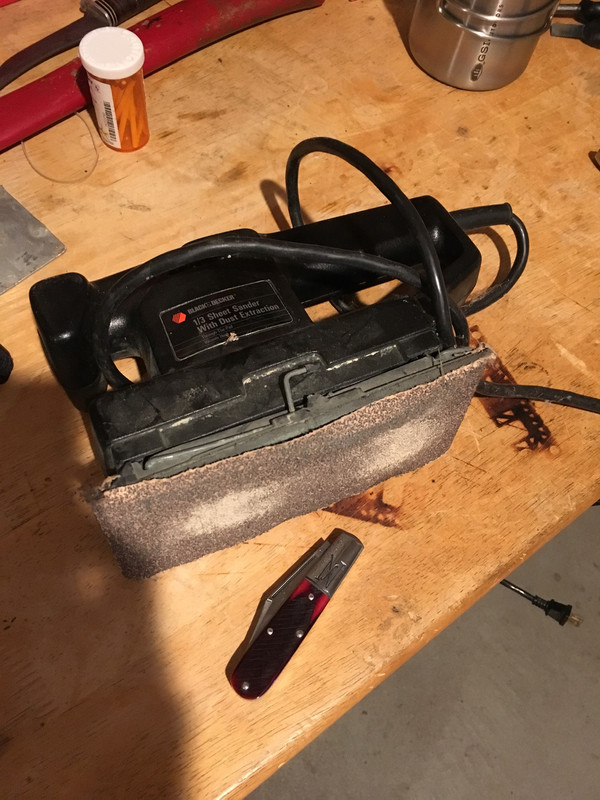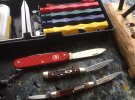- Joined
- Apr 20, 2018
- Messages
- 4,458
I really can’t believe I’m the only one using a more modern method to sharpen...

The BladeForums.com 2024 Traditional Knife is available! Price is $250 ea (shipped within CONUS).
Order here: https://www.bladeforums.com/help/2024-traditional/
I really can’t believe I’m the only one using a more modern method to sharpen...

I really can’t believe I’m the only one using a more modern method to sharpen...

I really can’t believe I’m the only one using a more modern method to sharpen...

More power! Tim Taylor would be proud.I really can’t believe I’m the only one using a more modern method to sharpen...

 I have yet to develop the skill of free-hand sharpening on a stone; I used to ruin knives by sharpening them badly on stones or using pull-through carbide sharpeners. The Lansky sharpening kit changed my life because now I can buy knives and know that I’ll be able to keep them sharp, but the kit doesn’t work for everything. The pen blade on my Old Timer (pictured) is too narrow to sharpen with the kit (at 20 degrees) because the stone hits the clamp jaws without contacting the blade edge.
I have yet to develop the skill of free-hand sharpening on a stone; I used to ruin knives by sharpening them badly on stones or using pull-through carbide sharpeners. The Lansky sharpening kit changed my life because now I can buy knives and know that I’ll be able to keep them sharp, but the kit doesn’t work for everything. The pen blade on my Old Timer (pictured) is too narrow to sharpen with the kit (at 20 degrees) because the stone hits the clamp jaws without contacting the blade edge.View attachment 1094546 I have yet to develop the skill of free-hand sharpening on a stone; I used to ruin knives by sharpening them badly on stones or using pull-through carbide sharpeners. The Lansky sharpening kit changed my life because now I can buy knives and know that I’ll be able to keep them sharp, but the kit doesn’t work for everything. The pen blade on my Old Timer (pictured) is too narrow to sharpen with the kit (at 20 degrees) because the stone hits the clamp jaws without contacting the blade edge.

I have more sharpening stones than I could ever care to photograph. My mother-in-law worked for Behr-Manning in Watervliet, NY during the Korean War, and my father-in-law was a small engine mechanic. When my wife and I cleaned out the family home after they passed away, we found about a zillion and one stones of various sizes.
I have have a ton of diamond stones, as well as a couple of guided systems. The Sharpmaker gets used a bit for setting edge bevels on more modern steels. But I mostly freehand sharpen these days.
Pictured are a few of my field sharpeners. I tend to accumulate field sharpening stones in leather slips. I have a bunch of them in various sizes, from Kabar, Case, BSA, Smiths, etc.
Also pictured is my homemade bench strop. I made it years ago, from an old piece of wood I found in the garage, and a large scrap of leather. I sand it down every year or two, and reapply the BRKT green compound. This strop is always out, and gets used constantly. Nothing in my house gets sharpened without at least a few passes on this strop. It's like an old friend to me.
...
I have more sharpening stones than I could ever care to photograph. My mother-in-law worked for Behr-Manning in Watervliet, NY during the Korean War, and my father-in-law was a small engine mechanic. When my wife and I cleaned out the family home after they passed away, we found about a zillion and one stones of various sizes.
I have have a ton of diamond stones, as well as a couple of guided systems. The Sharpmaker gets used a bit for setting edge bevels on more modern steels. But I mostly freehand sharpen these days.
Pictured are a few of my field sharpeners. I tend to accumulate field sharpening stones in leather slips. I have a bunch of them in various sizes, from Kabar, Case, BSA, Smiths, etc.
Also pictured is my homemade bench strop. I made it years ago, from an old piece of wood I found in the garage, and a large scrap of leather. I sand it down every year or two, and reapply the BRKT green compound. This strop is always out, and gets used constantly. Nothing in my house gets sharpened without at least a few passes on this strop. It's like an old friend to me.

Definitely nothing fancy here, but my amateur sharpening would be wasted on much else.I do need a good strop so if anyone has recommendations please PM me.






I use my jeans too.One more thing!!!
If you notice, I didn't include a strop of any kind in any of the pictures or the article I posted just above. Usually when I sharpen a knife, I am at a table or at my desk and usually wearing jeans. When I'm where I want to be with the edge, I just strop the blade on my jeans over my upper thigh. Just a few light strokes will bet rid of any wire edge and then give my final edge.
OK - here's the shocker. Sometimes I'll be in a pair of shorts and just give the blade a few strokes on the top of my bare thigh.
Everyone will find that there are small things they can do to enhance their sharpening experience. As I said in my above post, consistency and patience will pay off.

I use my jeans too.

